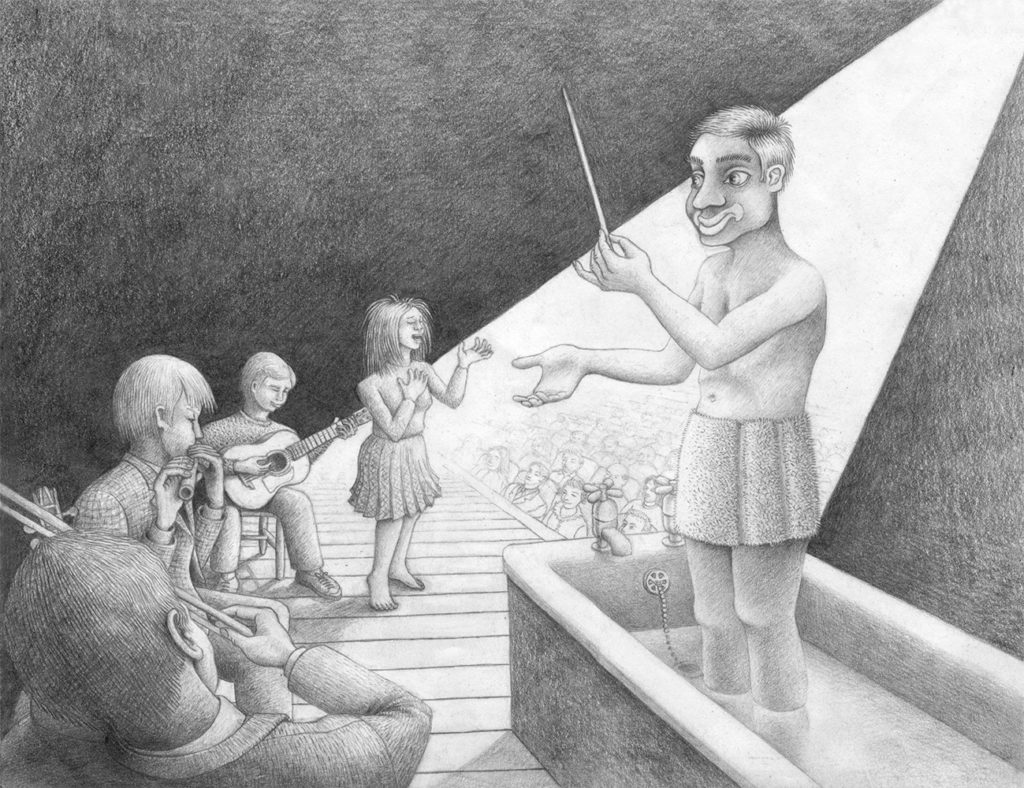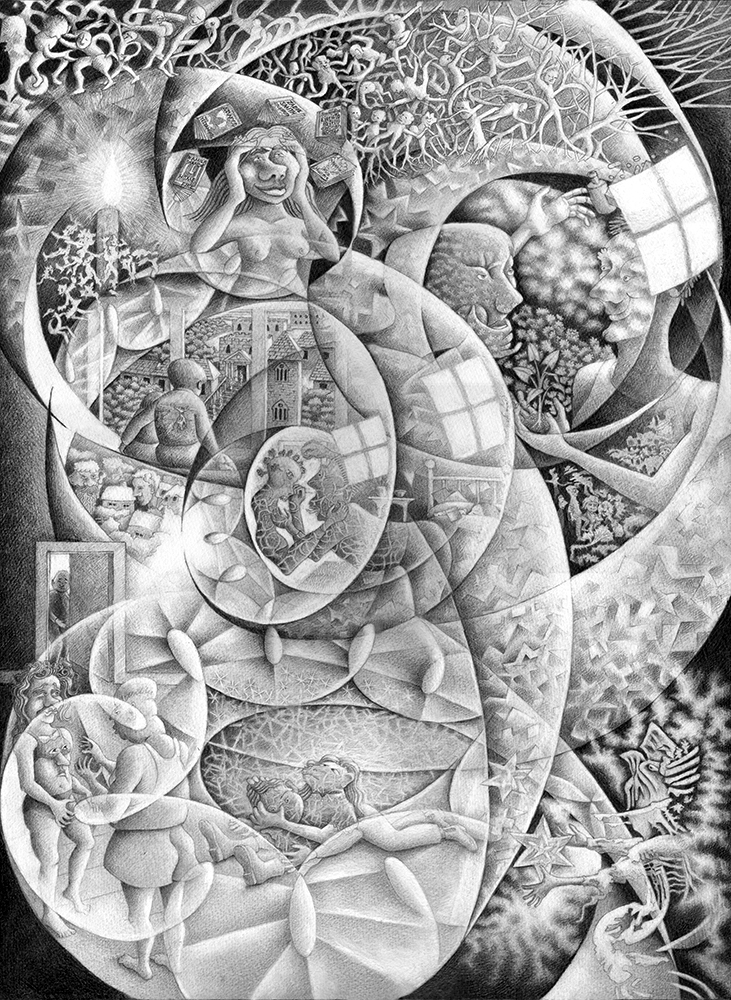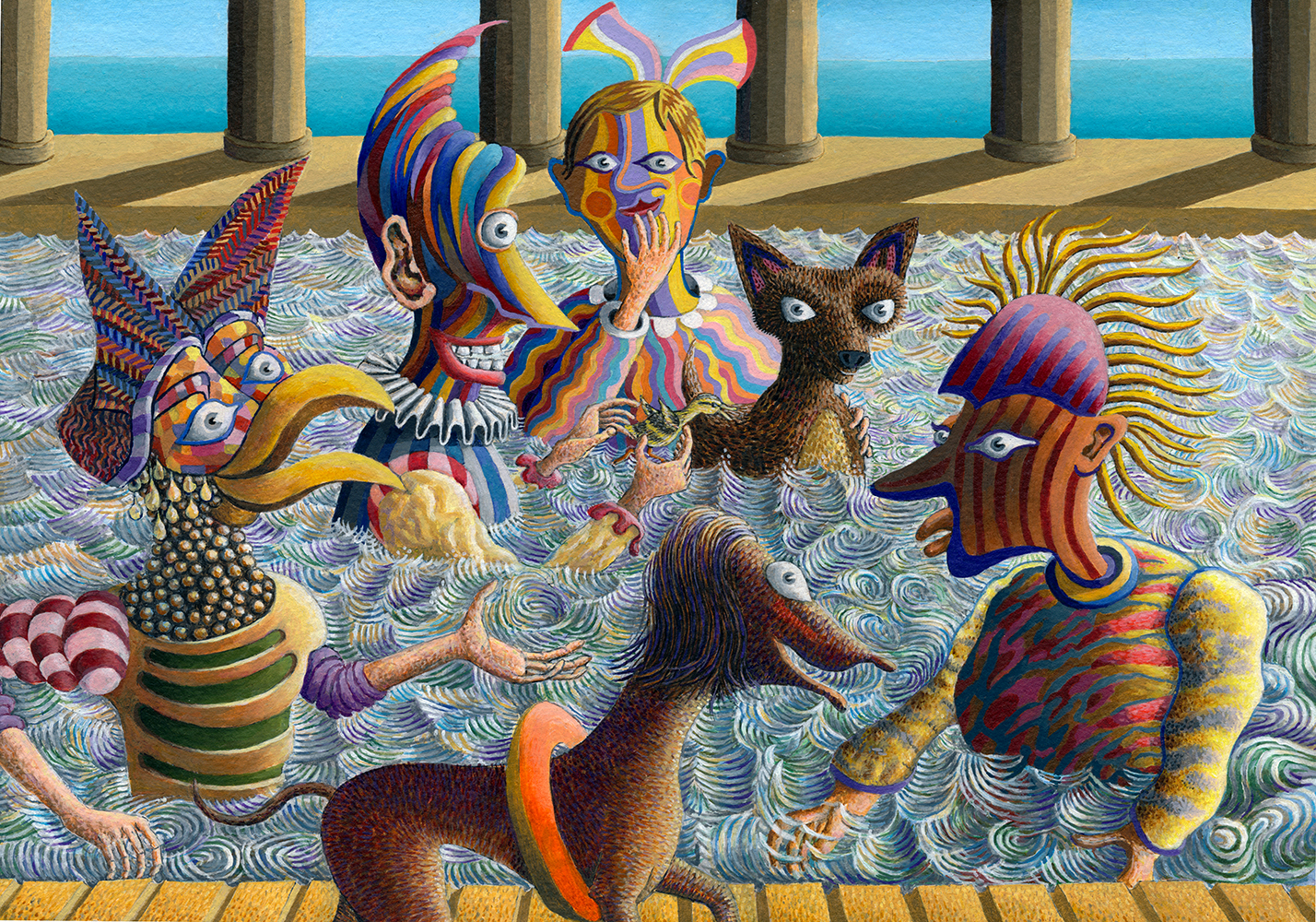![]()

For those who like to sing in the bath this takes us a little further. As in dreams, our bathroom is transported onto a concert stage where we have to conduct a group of folk singers before an attentive audience.


In 1988 I worked for a dictionary software company in Charlton-on-Otmoor, close to Oxford. At lunchtime, to escape from the programming, I walked through the magical world of plants, water and sky beside the River Ray.
![]()

This drawing shows a half-man, half-tree with long curly hair, which turns into a burning city above him. It was the time of the troubles in Northern Ireland and odd disembodied figures unfold around him.
![]()

My father grew up very happily in Hamburg where his father was Professor of Physiology at Hamburg University. He had to escape to England in the mid 1930s where he lived for the rest of his life. This drawing represents my attempts to come to terms with his rejection of Germany and the many contradictions of his life. It is all too easy, and this has been done many times, to spell out the atrocities of that time in stark detail. However, I have played this down in this drawing – although the message is the same – because the same forces of darkness have also arisen in countless other countries since then. So this artwork shows the point of view of an ordinary law-abiding man, who although not evil in himself, was drawn into evil by the powerful forces of others around him. And not just in Germany, this man can, and often does, exist in most countries in the world. My hope is that if we can present the right message to this ordinary man, he and the many like him, will gain the strength to resist the call of evil whenever it comes.
![]()

Humans do not have long necks (giraffe), legs built for speed (cheetah) or sharp canine teeth (wolf), but instead have cranes (to lift as high as trees), cars (to move fast) and guns (to kill). The idea behind this picture is that maybe our natural adaptation might be very like the world of nature, if we look at the many different roles we perform together in groups.
![]()

Charles Dickens’s Little Dorrit is hardworking and serious. Here, her namesake, Little Dorrito, is plump and humorous. Bored perhaps with the guilt-ridden Arthur Clennan (whom she marries in the book), she jumps instead into the arms of Panks (Mr Caseby’s clerk), whom Dickens describes as moving tugboat style ‘with a puff and a snort’.
![]()

Suppose that humans returned to live in trees like their distant ancestors. If so, they would need new technology to help them move from tree to tree. Here this is accomplished with helium-filled wings and a peddle-powered propeller to supply lift. However, even in these idyllic surroundings, will human society still continue with its arguing and fighting?
![]()

Jessica’s memories stream out of her head in all directions. Some are happy because they were friends, but some are a little weird, like the lady with an elephant’s trunk and the man eating fish and chips. The man behind her is her lover from the past. The children, with a canary, are memories from her happy childhood.
![]()

I made the Queen the centrepiece of this composition on hearing her speech to the nation during lockdown in May 2020. To visually interpret the music she was playing I created a series of patterns and rhythms superimposed on the trees. Musicians I admire are depicted in the large oak leaves above and include David Oistrakh and Yehudi Menuhin, playing Bach’s concerto for double violin.
![]()

The theme here is a pilgrimage by all artists to the urinal of Marcel Duchamp. Each travels with his most important work to the top of an enormous tower where the urinal resides. As in the Tower of Babel, every artist speaks in the voice of his favourite art movement such as Abstract Expressionism, Conceptualism and so on. To add spice, silly politicians move by the open archways, dressed and acting like the school children they are.


This is an attempt to illustrate time as time-lapse photography. A conductor with his hands moving to the beat of his music is repeated right across the composition. Each vignette he passes then breaks up into multiple images to show the passing of time. These, of course, all have their own individual story to tell, from an opera singer (bottom left) to the four horsemen of the apocalypse (top right).


This is the first variation in a triptych on the theme of memory. They all use the same twisting shapes as background, but each superimposes quite different stories on them. The underlying theme here is maladaptive relationships, starting with Harvey Weinstein (bottom left), then moving to squabbling parents (centre) and doctors arguing over pills or natural herbs (top right).


This second variation has another set of shapes superimposed on it. Then the shading of the internal patterns was reversed: where a star was black on one side of a line, it would be white on the other. Since the composition gave the impression of music playing, I added the opera singer and two string players.
![]()

Like all of us, the naked woman is tempted by the glitter of contemporary life promised by the skeleton. But alongside this, life and work must continue on the table of life. Here two figures perform their daily grind in the hamster wheel, while other members of the family get on with their everyday tasks.
![]()

Although this man is not based on anyone I know, he is a type I have often seen. Bluff and outspoken, he speaks his mind with no thought to the consequences. But contrary to his personality he is seated in a magical restaurant where the wallpaper has peeled away and come to life. Should he drink the fish swimming in his jug of water or add it to his other strange dishes?
